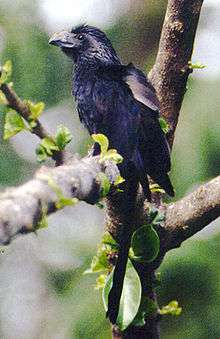Ani (bird)
| Ani Temporal range: Pleistocene - Holocene, 1.8–0 Ma | |
|---|---|
 | |
| Groove-billed ani, Crotophaga sulcirostris | |
| Scientific classification | |
| Kingdom: | Animalia |
| Phylum: | Chordata |
| Class: | Aves |
| Order: | Cuculiformes |
| Family: | Cuculidae |
| Subfamily: | Crotophaginae |
| Genus: | Crotophaga Linnaeus, 1758 |
| Type species | |
| Crotophaga ani Linnaeus, 1758 | |
The anis are the three species of near-passerine birds in the genus Crotophaga of the cuckoo family. They are essentially tropical New World birds, although the range of two species just reaches the United States. Recent DNA evidence places them in the group Crotophaginae.[1][2]
Unlike some cuckoos, the anis are not brood parasites, but nest communally, the cup nest being built by several pairs between 2–6 m high in a tree. A number of females lay their eggs in the nest and then share incubation and feeding.
The anis are large black birds with a long tail and a deep ridged black bill. Their flight is weak and wobbly, but they run well, and usually feed on the ground.
These are very gregarious species, always found in noisy groups. Anis feed on termites, large insects and even lizards and frogs. The claim that they will remove ticks and other parasites from grazing animals has been disputed; while there is no doubt that anis follow grazing animals in order to catch disturbed insects and will occasionally eat fallen ticks, there is no proof that they actively remove ticks from the animals' bodies.
Fossils of two ani species have been found from Pleistocene rocks, dated to between 1.8 million and 10,000 years ago.[3]
Species
- Greater ani, Crotophaga major
- Smooth-billed ani, Crotophaga ani
- Groove-billed ani, Crotophaga sulcirostris
- Cabo San Lucas groove-billed ani, Crotophaga sulcirostris pallidula - probably invalid; extinct (c.1940)
References
- ↑ Avise JC, Nelson WS, Sibley CG (June 1994). "Why one-kilobase sequences from mitochondrial DNA fail to solve the Hoatzin phylogenetic enigma". Mol. Phylogenet. Evol. 3 (2): 175–84. doi:10.1006/mpev.1994.1019. PMID 8075835.
- ↑ Payne, R.B. (2005). The Cuckoos. Oxford University Press.
- ↑ Brodkorb, (1971). "Catalogue of fossil birds: part 4 (Columbiformes through Piciformes)." Bulletin of the Florida State Museum, 15: 163-266.
- ffrench, Richard (1991). A Guide to the Birds of Trinidad and Tobago (2nd ed.). Comstock Publishing. ISBN 0-8014-9792-2.
- Hilty, Steven L (2003). Birds of Venezuela. London: Christopher Helm. ISBN 0-7136-6418-5.